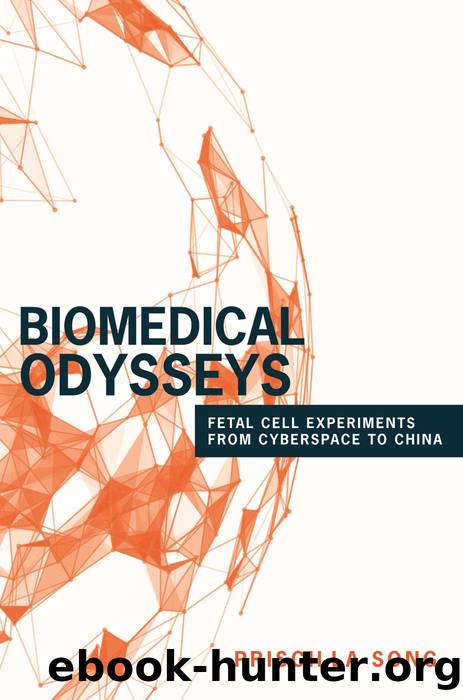Biomedical Odysseys by Song Priscilla

Author:Song, Priscilla.
Language: eng
Format: epub
Publisher: Princeton University Press
Published: 2017-07-14T16:00:00+00:00
PART III
HETEROGENEOUS EVIDENCE
INTERLUDE
CLINICAL OUTCOMES
Figure 7.1. Clinical data for 1,128 patients treated with olfactory ensheathing glial cell therapy (chart designed by Oikeat Lam). Neurological conditions and gender distributions compiled from data published in the Chinese Journal of Reparative and Reconstructive Surgery (Huang et al. 2009, 16).
CHAPTER 7
SEEKING TRUTH FROM FACTS
AS THE PROLIFERATION OF FETAL cell therapies suggests, the transition from laboratory bench to hospital bed is happening at an accelerated pace in contemporary China, with increasing numbers of new treatments being tested on patients. Researchers and regulators in the United States and Europe have lambasted Chinese practitioners for moving too quickly into human therapies without subjecting their treatments to the rigors of evidence-based medicine. Without proof in the form of placebo-controlled clinical trials, the critics charge, Chinese clinicians are deemed charlatans preying upon the desperation of patients. Medical entrepreneurs such as Huang are particularly susceptible to accusations of quackery as they negotiate the overlapping and at times competing motives of helping patients, advancing science, and making a profit.
The charge of medical fraud carries particular resonance in China. While the focus on evidence-based medicine is new, charges of quackery are not. Writer and social critic Lao She (老舍) satirized Chinese medical services in the 1930s in his short story “A Brilliant Beginning” (开市大吉 kāi shì dàjí), describing a group of charlatans posing as physicians who tried to make a profit by performing fraudulent injections (Lao 2011).1 Since the reintroduction of private enterprise during Deng’s Reform and Opening Up era, the country has been plagued by tales of counterfeit goods, from bootleg DVDs and pirated software to imitation handbags and fake cigarettes. The epidemic of fake and shoddy products produced in China has been particularly problematic in the medical realm, affecting domestic and foreign patients around the globe. Transnational scandals have included Chinese cough medicine laced with diethylene glycol2 and exported abroad, which fatally poisoned more than one hundred Panamanians in 2006 (Rentz et al. 2008). Counterfeit heparin,3 a blood thinner produced in China for the pharmaceutical giant Baxter, was linked to nearly a thousand cases of serious injuries reported to the U.S. FDA (Harris and Bogdanich 2008). Even infant formula has not been exempt from the tampering of unscrupulous manufacturers seeking to increase their profit margins.4 The label “Made in China” has thus become synonymous with suspect imitations that are not just poor quality but have even injured or killed thousands worldwide. Regulators, trade officials, and journalists have blamed the problem on corruption, cutthroat competition, and a lack of regulatory oversight that have encouraged manufacturers to cut corners in the race to the bottom line. Given this context of global suspicion for Chinese products, it is not surprising that experimental biomedical treatments in China have been interpreted as ploys by profiteering medical entrepreneurs. Yet thousands of patients from more than eighty countries have been convinced to undergo fetal cell transplantation in Beijing. Although critics have been quick to dismiss these biomedical odysseys as a matter of desperate patients duped by false hopes,
Download
This site does not store any files on its server. We only index and link to content provided by other sites. Please contact the content providers to delete copyright contents if any and email us, we'll remove relevant links or contents immediately.
| Automotive | Engineering |
| Transportation |
Whiskies Galore by Ian Buxton(41935)
Introduction to Aircraft Design (Cambridge Aerospace Series) by John P. Fielding(33085)
Small Unmanned Fixed-wing Aircraft Design by Andrew J. Keane Andras Sobester James P. Scanlan & András Sóbester & James P. Scanlan(32763)
Craft Beer for the Homebrewer by Michael Agnew(18193)
Turbulence by E. J. Noyes(7977)
The Complete Stick Figure Physics Tutorials by Allen Sarah(7333)
Kaplan MCAT General Chemistry Review by Kaplan(6895)
The Thirst by Nesbo Jo(6874)
Bad Blood by John Carreyrou(6580)
Modelling of Convective Heat and Mass Transfer in Rotating Flows by Igor V. Shevchuk(6406)
Learning SQL by Alan Beaulieu(6235)
Weapons of Math Destruction by Cathy O'Neil(6204)
Man-made Catastrophes and Risk Information Concealment by Dmitry Chernov & Didier Sornette(5951)
Digital Minimalism by Cal Newport;(5697)
Life 3.0: Being Human in the Age of Artificial Intelligence by Tegmark Max(5506)
iGen by Jean M. Twenge(5384)
Secrets of Antigravity Propulsion: Tesla, UFOs, and Classified Aerospace Technology by Ph.D. Paul A. Laviolette(5330)
Design of Trajectory Optimization Approach for Space Maneuver Vehicle Skip Entry Problems by Runqi Chai & Al Savvaris & Antonios Tsourdos & Senchun Chai(5035)
Pale Blue Dot by Carl Sagan(4947)
